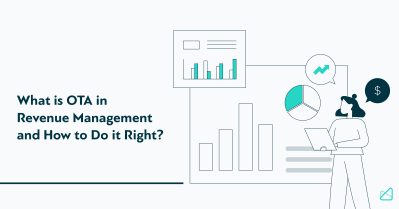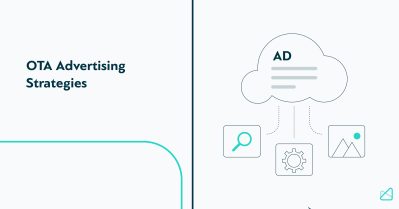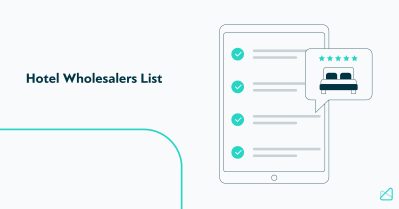7 KPIs for OTAs that you SHOULD be watching already

Online travel agents must evolve to overcome today’s challenges while remembering why customers loved them in the first place
The outlook for the international travel industry remains broadly positive, although price growth is expected to slow. Despite a projected 3.5 percent growth for the global economy in 2020, airfares are set to increase by a modest 1.2 percent, hotel rates by 1.3 percent, and rental car rates up one percent during the year ahead.
In addition to sluggish growth, online travel agents (OTAs) are facing an increasingly competitive marketplace, a rise in operating costs, and pressure on margins.
With the launch of Google Travel earlier this year, the search giant is emerging as a serious competitor in the OTA space.
And in order to stay high in its search results, OTAs are still having to hand Google billions of dollars each year in search engine marketing fees – a cost which can account for as much as one third of an OTA’s revenue. This can affect the profit margin in tourism industry significantly.
There is also potential pressure on margins as travel and hospitality operators strive to reduce their distribution costs as well as trying to get more travelers to book directly with them. Some resort to dynamic packaging to improve their offer.
Online travel agency performance metrics or KPI
In the face of such challenges, now is a good time to review your key performance indicators (KPI) and perhaps re-model them or establish some new ones. Keep in mind that big data in the travel industry can become a problem if you don’t prepare for it.
Remember that your acquisition KPIs must be measurable and have a target (usually a numeric value) within an established timeframe. Although related, KPIs are not the same as the metrics used in your financial reporting. KPIs tend to be expressed as percentages or ratios that allow you to see how different areas of your business are performing in relation to each other. Each of your KPI must also be based on a specific data source so there is no ambiguity as to how each KPI is measured and monitored.
We understand that your primary goal is to sell travel products and make the biggest return on investment while doing so. Therefore it is sensible to use a collection of KPIs that closely focuses on managing your costs while at the same time tracking your online reach.
During the good times it is easy and understandable to bask in the glories of your top-line growth. The danger, however, is that to keep feeding your revenue growth, your cost of sales metric starts to creep up, ultimately eating into your profits.
Online travel agency KPI examples
The following KPI will tell you a lot about your sales and marketing strategy but also your operation in general.
Cost-of-Sales Percentage
Definition
Cost-of-Sales Percentage is the total cost of converting a sale in relation to the revenue it generated. It is also known as the expense ratio. Ideally, you should have software or reporting capabilities that allow you to see how each individual sales channel is performing for you. This will enable you to intelligently allocate your ad spend and marketing budget.
How to measure it
Cost-of-Sales Percentage = Click Costs Per Purchase ÷ Revenue from Purchase.
Example
A customer buys a travel package that costs $1,000 and the cost of the clicks to make that purchase was $100, then the Cost-of-Sales Percentage is 10%.
Cost Per Acquisition
Definition
Cost per Acquisition tells is an acquisition KPI that defines how much you’re spending on advertising in relation to how many sales you are making. Again, ideally you will be able to calculate Cost per Acquisition in each individual channel to help you understand which are profitable and which are not.
How to measure it
Cost Per Acquisition = the total cost of an ad campaign ÷ the number of sales made.
Example
You spend $500 on a Google ad campaign in March and you get five sales. Your Cost Per Acquisition is $100.
Return on Adverting Spend
Definition
Return on Adverting Spend is one of the simplest marketing metrics to measure the effectiveness of a digital advertising campaign. For every dollar spent in one specific pay-per-click channel, for example, how much did you make in revenue? A widely-held benchmark for Return on Ad Spend is a ratio of 4:1.
How to measure it
Total revenue ÷ advertising spend = return on ad spend
Example
You spend $2,500 on an advertising campaign in July and take $10,000 in revenue during the same period. Your Return on Advertising Spend is 4:1
Conversion Rate

Definition
Calculating your conversion rate is a simple but very insightful metric for OTAs which basically indicates the overall effectiveness of your website, app, booking engine and advertising.
How to measure it
Number of sales ÷ number of website visits = conversion rate
Example
Your website or app had 8,000 visits last month. In the same period you made 400 sales. Your conversion rate was 5%.
Average Sale Value
Definition
Average Sale Value is the average sum of money customers spend when making a purchase with you.
How to measure it
Total sales revenue ÷ the total number of sales made for a given period = average sale value.
Example
You had a total of $30,000 in sales last month from 30 transactions. Your Average Sale Value was $1,000.
Abandonment rate
Definition
Shopping car abandonment rate refers to the percentage of customers who added at least one product to their online cart but did not complete the sales process.
Globally, the average abandonment rate for OTAs is 93.96 percent, so this is something to benchmark your own performance against. Generally, the most complex travel purchases are made on OTA sites, where travelers may be booking a range of travel products, unlike car rental or hotel sites that have lower abandonment rate percentages.
How to measure it
Total number of shopping carts created ÷ total number of completed transactions
Example
You had 100,000 visitors who actively started the purchasing process on your website or app in May but only 7,000 actually completed it. Your abandonment rate was 93%. The look to book ratio is also an important metric to follow.
Customer Lifetime Value
Definition
Customer Lifetime Value can be a little tricky to measure and the metric can be calculated with varying degrees of sophistication. In a nutshell it is an attempt to calculate the entire net profit generated by each customer over the whole span of the customer relationship.
How to measure it
(Annual profit from customer – costs to acquire customer) multiplied by length of time served as a customer.
Example
The profit made from the customer is $1,000 each year, the acquisition costs were $2,000. She is expected to be a customer for five years so the Customer Lifetime Value is $1,000 multiplied by 5 – $2,000 = $3,000.
In the face of today’s challenges, some commentators have suggested that OTAs need to take radical action in order to survive. Ideas floated include becoming more like traditional travel agents and even opening call centres and stores; reducing reliance on online advertising and instead investing in TV, radio and billboards; or becoming all-round travel advisors by harnessing the power of artificial intelligence.
Some of these ideas may sound a little extreme but that does not mean they should be discredited out of hand. At the same time, OTAs must not lose sight of what made them popular in the first place: having an intuitive website that is quick and easy to navigate; a one-stop-shop for all travel needs irrespective of the brand; and, last but certainly not least, the best available prices.
Subscribe to
our newsletter
Yay! You are now
subscribed to our
newsletter
Mize is the leading hotel booking optimization solution in the world. With over 170 partners using our fintech products, Mize creates new extra profit for the hotel booking industry using its fully automated proprietary technology and has generated hundreds of millions of dollars in revenue across its suite of products for its partners. Mize was founded in 2016 with its headquarters in Tel Aviv and offices worldwide.
Related Posts

What is OTA in Revenue Management and how to do it right?
11 min. A hotel revenue management strategy is usually a comprehensive strategy encompassing various analytics and demand forecasting tasks to custom tailor pricing and distribution strategies. While there are many independent hotels, most hotels list their accommodations through OTAs. But where does that leave OTAs? The OTA market is quite dynamic and has some serious […]

5 OTA Advertising Strategies That Work
8 min. Online travel agencies or simply OTAs have plenty of opportunities to market their offer to the target customers. Some strategies focus more on generating exposure, while others generate more leads and increase conversion rates. There are also more and less efficient advertising strategies. One common question that continues to trouble online travel agents […]

The Most Complete Hotel Wholesalers and Bed-Banks List
28 min. Finding a professional and reliable hotel wholesaler is not an easy task. There are dozens of hotel wholesalers to choose from on the current market. However, they are not all the same. Some are better than others in terms of the commercial conditions they offer, the variety of hotels they have access to, […]
